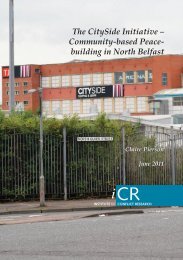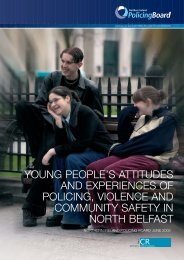Young People and Interfaces Report - Institute for Conflict Research
Young People and Interfaces Report - Institute for Conflict Research
Young People and Interfaces Report - Institute for Conflict Research
You also want an ePaper? Increase the reach of your titles
YUMPU automatically turns print PDFs into web optimized ePapers that Google loves.
YOUNG PEOPLE AND INTERFACES<br />
findings with a view to them putting <strong>for</strong>ward their own ideas on how they could be more included in<br />
dialogue <strong>and</strong> consultation around interface issues.<br />
The purpose of the initial focus group discussions was to explore what life is like <strong>for</strong> young people<br />
living in interface areas. In particular we sought to assess attitudes to living in their local area,<br />
perceptions of safety <strong>and</strong> the role of barriers in terms of providing security, views on any impacts<br />
that living at an interface may have on their daily lives, <strong>and</strong> thoughts as to what needs to happen in<br />
the future with regards to developing interface areas.<br />
During the course of the research, where possible focus groups were organised in relatively small<br />
groups of young people (between 5-8 persons) to facilitate conversations where all of the young<br />
participants felt com<strong>for</strong>table becoming involved. One focus group however was mixed <strong>and</strong><br />
consisted of more than 10 young Protestants <strong>and</strong> Catholics, male <strong>and</strong> female. It became apparent<br />
in this group that the most assertive or dominant voices were those of young Catholic males, <strong>and</strong><br />
in particular young Protestant females were reticent to be drawn into the conversation. In this<br />
instance the young females in question had to be gently encouraged to give their opinion when<br />
they felt com<strong>for</strong>table in doing so.<br />
This firstly highlights the power dynamics that can underpin structured discussions <strong>and</strong> also<br />
indicates that in terms of numbers engaging in focus groups, smaller groups often lead to more indepth<br />
<strong>and</strong> better quality discussion. It also indicates that gender, age, community background <strong>and</strong><br />
individual confidence can all impact upon a young person’s participation in discussion, <strong>and</strong> it is<br />
worth bearing this in mind in particular when either mixed focus groups of Catholics <strong>and</strong><br />
Protestants or young males <strong>and</strong> females are being organised. A few dominant voices prevalent<br />
amongst one gender or community background can make others less com<strong>for</strong>table about speaking<br />
openly.<br />
This small research project has attempted to draw upon the approach utilised by the ‘new<br />
sociology of childhood’ which views children <strong>and</strong> young people as competent actors in their own<br />
right (Leonard 2006a: 228; James <strong>and</strong> Prout 1990). Referring to young people as the ‘future’ can at<br />
times ignore their role in the present, <strong>and</strong> dismisses their views as only potentially <strong>and</strong> not actually<br />
relevant to the contemporary situation (Smyth <strong>and</strong> Scott 2000: 113). As such young people are<br />
often either ‘demonised’ or portrayed as ‘victims’ without agency, 6 perhaps most visibly so by the<br />
media (Andersson <strong>and</strong> Lundstrom 2007). 7 In the Northern Irish context, such negative associations<br />
which often associate young people <strong>and</strong> violence were very evident during the television coverage<br />
of the riots at the Lower Newtownards Road/Short Str<strong>and</strong> interface in June 2011.<br />
There has been a plethora of research conducted on issues impacting upon residents in interface<br />
areas, <strong>and</strong> those studies which have focused on young people have tended to specifically focus on<br />
the relationship between interface areas, young people <strong>and</strong> violence (Jarman <strong>and</strong> O’Halloran<br />
2000; 2001; Byrne et al. 2005; Hansson 2005). While not shying away from engaging with these<br />
issues, this process aimed to be slightly more open-ended <strong>and</strong> hopes to shed some light on the<br />
views of a limited number of young people on what life is like <strong>for</strong> them growing up in interface<br />
areas in 2012.<br />
6 A Youthnet consultation response in April 2011 to the proposed community safety strategy talks of young people still being talked about as if a ‘problem<br />
to be solved’. The document argues that where this negative stereotyping remains in place it will have an adverse impact on children <strong>and</strong> young people<br />
in terms of ‘criminalisation’ <strong>and</strong> unnecessary contact with the criminal justice system. The response is available online at<br />
http://www.dojni.gov.uk/index/public-consultations/archive-consultations/consultation_on_a_new_community_safety_strategy_<strong>for</strong>_ni/youthnet.pdf<br />
Accessed 28th March 2012.<br />
7 See, Andersson, G., <strong>and</strong> Lundstrom, T. ‘Teenagers as Victims in the Press’. In, Children <strong>and</strong> Society, Volume 21 (2007) pp. 175–188.<br />
8






